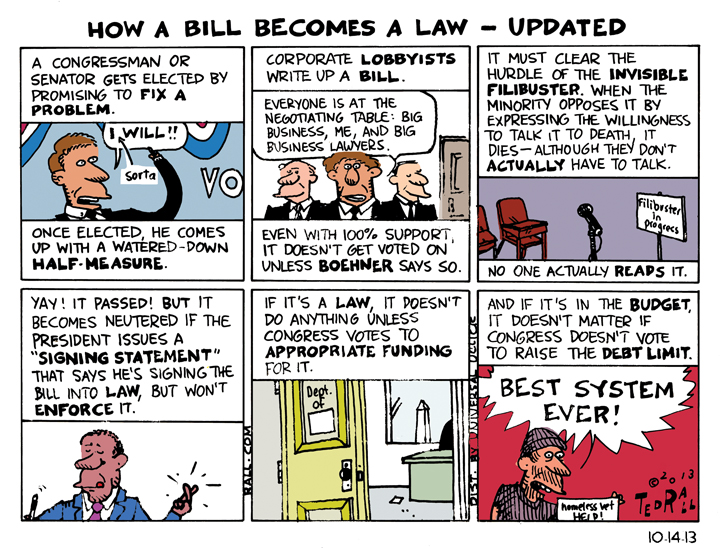Everything you need to know about how a bill becomes law – or not – in today’s dysfunctional Congress. From signing statements to invisible filibusters to debt limits, it’s the best system of government anyone ever came up with.
How a Bill Becomes Law – Updated

Ted Rall
Ted Rall is a syndicated political cartoonist for Andrews McMeel Syndication and WhoWhatWhy.org and Counterpoint. He is a contributor to Centerclip and co-host of "The TMI Show" talk show. He is a graphic novelist and author of many books of art and prose, and an occasional war correspondent. He is, recently, the author of the graphic novel "2024: Revisited."

3 Comments. Leave new
Your cartoon sparked some thinking on my part on the manner in which one particular bill became law – the one banning NASA and the OSTP from cooperating with their counterparts in China which was passed in 2011 and duly signed into law by Mr Obama and which has resulted in some consternation in the scientific community in the United States (http://www.theguardian.com/science/2013/oct/05/us-scientists-boycott-nasa-china-ban), with the main author, Frank Rudolph Wolf, forced by the uproar to claim that it was being misinterpreted and misapplied. The fact of the matter is that contrary to what one might expect, there never was a real discussion on the bill which lead to a vote in the US Congress on its merits, after which the president, after duly weighing its advantages and disadvantages, signed it into law. Rather, it was added to a spending bill in 2011, which, had it not been passed and signed into law, would have shut down (parts of) the federal government (sound familiar ?) and thus railroaded through the Congress and the Executive. Such is the nature of the legislative process which is held up as a model for all states which wish to be considered within the pale….
Henri
Since so much of the Constitution is ignored as being a “quaint document” perhaps the actual practices in use should be documented and placed in the public view.
This would be more honest and would subject the de facto constitution now in operation to the invective it deserves.
I forgot to mention, Ted, that this cartoon is high on my list of favorites by you.